Here, however, is evidence to the contrary.
Recently, 14 auctions were listed by a seller on Yahoo Japan Auctions (YJA) consisting of Transformer and Diaclone prototype toys in varying conditions. The bulk of the seller's other auctions seemed to be women's clothing, making the listings even more unusual. The item descriptions read, "These were about to be thrown away from a relative's factory that went out of business. I thought they were cute and took them home." (I guess she knew enough to put them on YJA and label them as Diaclone and Transformer items.)
While the small listing photos might have given the impression that these were merely a group of broken toys, a closer inspection would be sufficient to elicit goosebumps and sweaty palms from any informed collector. I do not think it would be out of line for me to say that this is probably one of the most significant prototype finds in the past few years for Transformer collectors. Although I did not have pockets sufficiently deep to carry away any of these treasures, hopefully I can share the seller's photos and my knowledge on the subject.
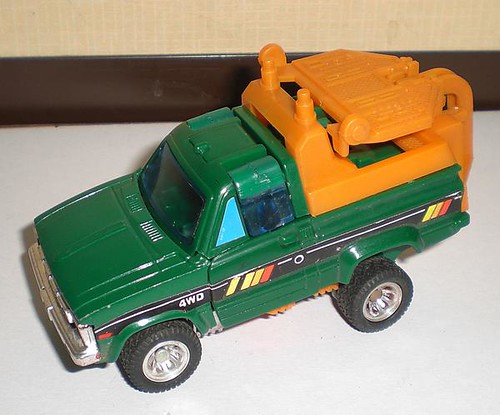
1. Hoist prototype.
This is the one piece that I nearly won, as it ended for a relatively low price. Based on my inspection of the auction photographs, this prototype appears to be in nearly finished form; likely, it is merely lacking paint on the head (which was sadly not shown).
However, there are two minor details that make this an unusual item. First, the stickers are obviously mismatched with this toy- this prototype uses Trailbreaker (Diaclone 4WD Hilux) stickers, rather than the black-and-yellow hazard stripe that typically decorates both Hoist and his Diaclone predecessor. The second anomaly is barely perceptible to the casual glance. If you look closely at the chrome front bumper, some of the chrome has rubbed away to reveal red plastic. The production version of Hoist uses an orange plastic base for this piece (the corresponding part for Trailbreaker, however, does use red plastic).
I can't really come up with an explanation for these deviations, aside from factory error. As far as I know, Hoist and Trailbreaker were generated from their respective pre-existing Diaclone toys. This seems to eliminate the possibility that these are 'halfway' products from the remold of one into the other. While the head is not shown, I am fairly confident that it is normal Hoist head (and not a 'Mexican Hoist' head).
Curious, but I didn't want to break the bank on this one.
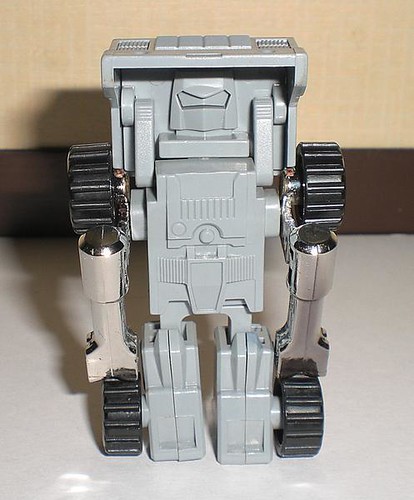
2. Huffer prototype.
This was one of the few items in the group that was really obviously a prototype.
Although grey, this Huffer is probably not resin since the material appears shiny, whereas resin generally has a matte finish. Interestingly, the toy otherwise appears to be close to its final form. Even the arms are chromed.
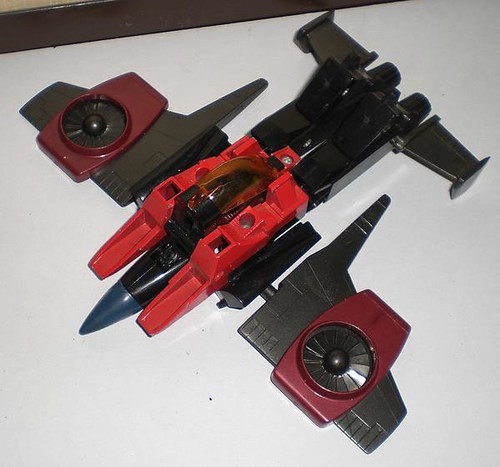
3. Thrust prototype.
There were a few Seeker prototypes in the set of auctions. No accessories were included, and most were simply cast in a different color or lacking paint.
This one was significant for a couple of reasons. First, the die-cast portion was painted red and the nosecone is blue, which would be typical of a Starscream body (disregarding the black portions), not Thrust. Granted, it is possible that the Thrust wing pieces were simply mis-matched with this body. However, this prototype brings to mind an early model of Dirge from Takara advertising materials (seen here at Maz's comprehensive TF-1 article on Diaclone/TF jets). As you can see, it is nearly identical to the one in the photo, except that the toes of this prototype are not cast in blue plastic. Thrust was also present for that photo shoot. Very interesting indeed.
Second, the canopy is clear orange, not clear smoke plastic as would have been found on Starscream (or his Diaclone predecessor) and Thrust. So the combination of parts and paint does not really match any toy that existed under either Diaclone or TF lines!

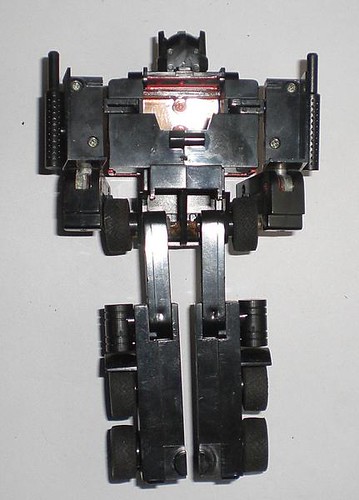
4. Convoy (Optimus Prime) prototype.
Similar to many of the other prototypes being auctioned, Convoy features black plastic instead of the normal blue and red plastic. No metallization has been applied to the chrome parts, but the die-cast portions are painted in the correct colors.

5. "Microchange" Broadcast (Blaster) prototype.
For reasons I will explain shortly, I really, really wanted to take this one home from the auction. I bid an amount that I thought was absurdly high- but it still was not enough. Blaster (or Broadcast, as he is known to Japanese collectors) was a childhood favorite of mine. I can still remember playing with a rather beat-up example in my preschool class... on those days that I could beat the other kiddies to it, anyway. Owning something like this would be a dream come true for me, but photographs will have to suffice for now.
I nearly overlooked Blaster because of the rather mundane photograph used for the auction listing. Unless you have very sharp eyes, there are virtually no differences from the item pictured in this photograph relative to a production version. Perhaps you note that the right leg is misassembled.
But turn him around...
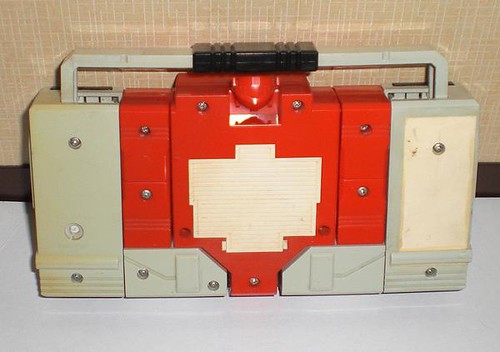
Amazing. This prototype is essentially in an intermediate stage of engineering where open portions of the original Microchange MC-21 Radicasse Robo toy were filled in to create the toy of Blaster that we know and love here in the U.S. (and elsewhere). Y'see, the Microchange toy (on which Blaster was based) is a real, working radio (unlike the non-working 'Soundwave' Cassette Man) with a bunch of moving parts and electronic components needed to enable this functionality. No wonder MC-21 and Blaster were enormous compared to the other Microchange and Transformer toys! When MC-21 was converted to the non-working Blaster toy, the electronics had to be gutted and the open spaces filled in.
Batteries were stored in the right leg of MC-21 and its back compartment was used to hold the transforming cassette robots (which could not fit in the tape deck). Here you can see that both spaces have been puttied over, as they are solid pieces in most Blasters (although some were left with an open back compartment). Returning to the front of the toy, the black dial to the left of the tape deck (your left) on MC-21 has been removed on this prototype. The robot head (not shown here) was also revealed to be unpainted in subsequent photographs.
So this is quite literally a "Microchange" Blaster, as the factory used MC-21 molds to cast a prototype in Blaster's colors, assumedly to reengineer the toy design. The historical value of this prototype is staggering given the massive overhaul of the design, and interesting as well, from the standpoint of seeing the Microchange toy in the classic Transformer colors. The Blaster in this auction is definitely the holy grail for prototype enthusiasts as it displays both non-production plastic colors and visible alteration to the design.
I am getting worked up on this again, and I certainly do not want to steal from the thunder of...
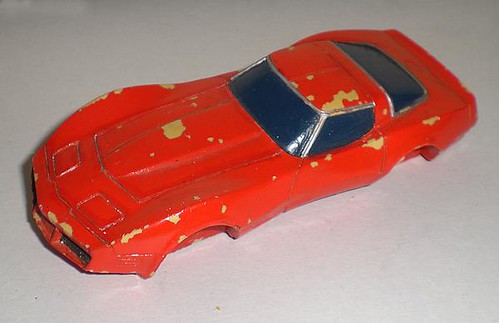
A broken wood car! Not quite.
Among the auctions listed were 3 similar items each called "Red Sports Car Robo," appearing to be bits and pieces from the Diaclone Corvette Stingray (which would later be known as the Transformer Tracks). Each of the 3 reflected one transformation mode of the toy: car, flying car and robot.

This was only a little strange, until I noticed that one of the auctions showed the underside of the car mode. And it was a BLOCK OF WOOD. That nearly required me to take my second shower of the day. Not only was one item wood-containing, all 3 appeared to be hand-painted wood and resin prototypes of the Diaclone toy upon further inspection. There are no internal parts apparent on any of them, except to the extent that such pieces are externally visible in the transformed mode. Very early toy prototypes are often made by hand-painting an approximated form or an existing toy (i.e., if it is a repaint).

In this photograph, you can see that the missiles are simply wooden pegs with triangular fins glued on to their sides. The backpack (to which the missiles connect) is also very noticeably altered from the final product. There is also a large grey piece included with the flying car mode auction. I am not sure what this represents. Perhaps it was a part from another toy or a discarded accessory that did not make it into the final production version.

Unfortunately, the robot mode was missing its head. It was in the worst shape of the 3 prototypes, probably because of the more fragile nature of its construction.
Now there was one thing that bugged me about this prototype: the yellow wings. While there were a few variations from the final product visible on this early prototype- as there should be- big yellow wings were a fairly significant deviation from the final product (which would have more streamlined blue wings). And I began to wonder if the prototype had been derived from pre-existing artwork or something of like nature. Turns out, it was.
The Corvette Stingray was one of the last Diaclone Car Robots to be produced in 1984 and was barely featured in product catalogs as a result. The one catalog scan that I could locate on the Internet is here at the extensive 1501bc.com website. And the tiny picture of the Corvette Stingray indeed reveals big yellow wings.
And so, this is:
6. Diaclone Corvette Stingray, wood and resin catalog prototype.
My conclusion is that this prototype is either (1) the actual model used for the catalog photo or (2) a model on which the catalog image was based. The catalog picture of the Corvette Stingray is indistinct to the point where I cannot make out whether it is a photograph or drawing. It also appears to have a red head, rather than a blue head (which makes the robot mode prototype's loss of its head a real shame). The backpack (to which the missile launchers attach) appears much larger in the catalog picture than the piece used on the production toy- perhaps this is the unidentified large grey piece in the flying car auction.
The odds of something of this nature surfacing after 25+ years are so unbelievably low, I am astonished that someone found this and had the presence of mind to put it up for auction instead of throwing it away. Equally astonishing was the ending bid on all 3 auctions, which hit 4 digits for 2 of the 3. A little crazy when you realize that people were essentially bidding on a broken bunch of wood, resin and screws.
A majority of the auctions appear to have sold to overseas buyers, judging from the numerous winning bids from Celga and Rinkya IDs. While a bit unfortunate for Japanese collectors, this gives me hope that the prototypes from these auctions will be accessible to a wider audience in the future.
-----
- All photographs used for this article are mirrored from the original auction images used in connection with each respective item.
- With respect to information regarding Thrust, credit and thanks to Maz at Tf-1.com, Early G1 Decepticon Jets - Prototypes, Pre-production and Early Release, Tf-1.com, at http://www.tf-1.com/articles/eurous_frame.php?art=earlyjets (last visited May 15, 2010).
- With respect to information regarding Blaster and Microchange MC-21 Radicasse Robo, credit and thanks to the 1501bc.com website (http://1501bc.com) and Blaster (G1), Transformers Wiki, at http://tfwiki.net/wiki/Blaster (last updated May 15, 2010).
- With respect to information regarding Diaclone Corvette Stingray, credit and thanks to the 1501bc.com website (http://1501bc.com) and Maz at Tf-1.com, E-Hobby Exclusive 94 "Road Rage", Tf-1.com, at http://www.tf-1.com/articles/reissue_frame.php?art=Roadrage (last visited May 15, 2010); Diaclone Black Corvette Stingray (Tracks) + Lucky Draw Reissue Black Tracks, Tf-1.com, at http://www.tf-1.com/articles/pretf_frame.php?art=blacktracks (last visited May 15, 2010; Diaclone Car Robot Product Numbers + Release Order, Tf-1.com, at http://www.tf-1.com/articles/pretf_frame.php?art=prod (last visited May 15, 2010).

Awesome post! Really informative, fascinating stuff.
ReplyDelete